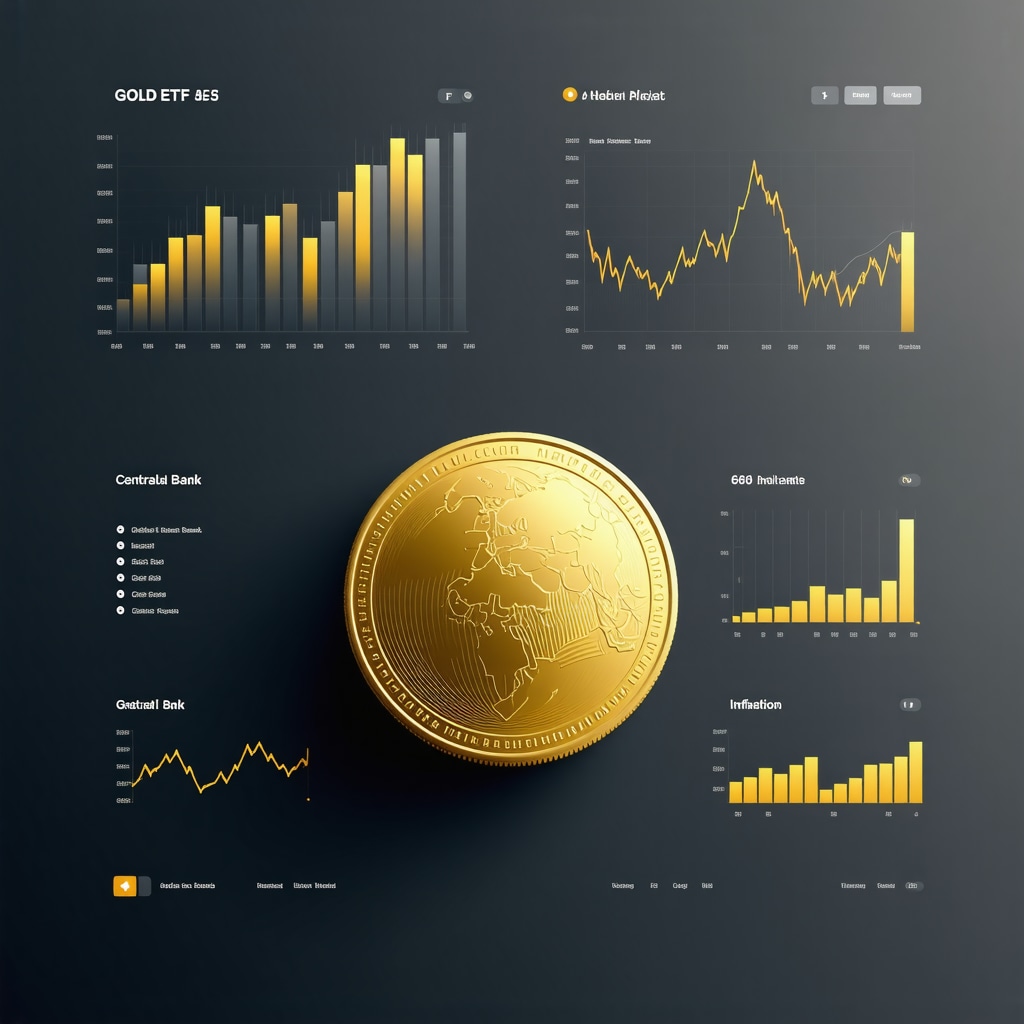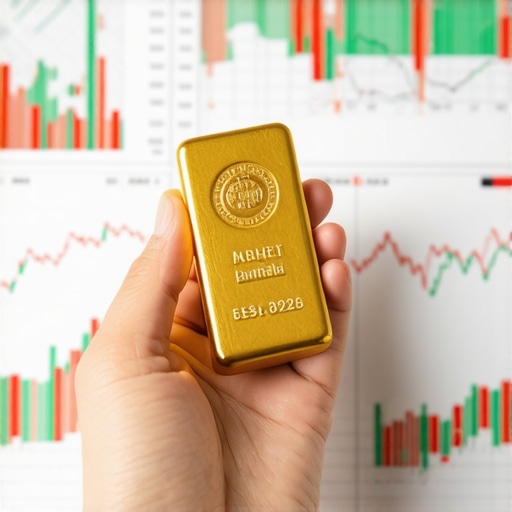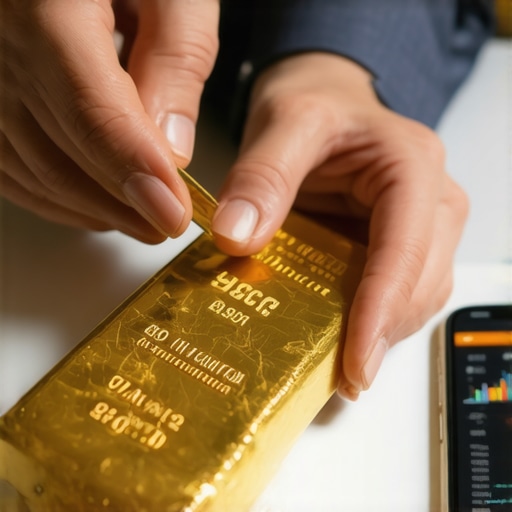Unlocking the Golden Gateway: Why Gold ETFs Are a Smart Starting Point for New Investors
For individuals venturing into the world of investment, gold exchange-traded funds (ETFs) offer an accessible, liquid, and cost-effective entry point into precious metals. Unlike buying physical gold, which requires secure storage and authentication, gold ETFs represent ownership of gold assets without the logistical burdens. This guide unpacks the nuanced benefits and essential steps to start investing in gold ETFs, providing beginners with clear, expert-backed direction.
Decoding Gold ETFs: Beyond the Basics of Digital Gold Ownership
Gold ETFs function as securities traded on stock exchanges, designed to track the price of gold. Each unit corresponds to a specific quantity of physical gold held by the fund. This structure allows investors to gain exposure to gold price fluctuations without the need to purchase or store physical bullion. Understanding the underlying mechanism — including fund management, expense ratios, and tracking accuracy — is vital to make informed investment decisions.
What Are the Key Considerations Before Investing in Gold ETFs?
Before diving in, consider your investment objectives and risk tolerance. Gold ETFs can act as a hedge against inflation and market volatility, but they also carry risks such as tracking errors and market liquidity constraints. Additionally, scrutinize the ETF’s expense ratio, fund size, and the credibility of the issuer. For example, funds like SPDR Gold Shares (GLD) have established reputations and robust liquidity. Consulting authoritative financial resources such as the Investopedia guide on gold ETFs can deepen your understanding.
Step-by-Step Blueprint: How Beginners Can Successfully Buy Gold ETFs
First, open a brokerage account if you don’t already have one, prioritizing platforms that offer low fees and easy ETF trading. Next, research and select gold ETFs that align with your financial goals; consider diversification within your portfolio to mitigate risks. Place your buy order during market hours, and monitor your investment regularly to respond to market trends. Practical experience shows that incremental investing over time, rather than lump-sum purchases, can smooth cost basis and enhance long-term returns.
Smart Strategies to Optimize Your Gold ETF Investment Journey
Begin with a modest allocation of your portfolio dedicated to gold ETFs — typically between 5% and 10% — to balance growth opportunities with risk management. Stay informed about global economic indicators and central bank gold purchases, which critically influence gold prices. For deeper insights into market dynamics, explore detailed analyses like those found in Comprehensive Gold Market Analysis for Informed Investment. Consider complementing gold ETFs with other gold-related assets, such as mining stocks or mutual funds, to diversify exposure and potentially enhance returns.
Engage and Grow: Your Next Steps in Mastering Gold ETF Investment
Are you ready to take the next step in securing your financial future with gold ETFs? Share your experiences or questions in the comments below to join a community of savvy investors. Explore additional resources and strategies by reading our Step-by-Step Guide to Buying Gold ETFs for Beginners and discover how to optimize your portfolio with expert advice.
Leveraging Macro Trends to Enhance Gold ETF Portfolio Performance
As global economic landscapes evolve, understanding macroeconomic factors becomes essential for optimizing gold ETF investments. Factors such as inflation rates, currency fluctuations, and geopolitical tensions directly impact gold prices. For instance, during periods of rising inflation, gold traditionally acts as a safe haven, often leading to price appreciation. Investors who monitor central bank policies, especially those related to interest rate adjustments and gold reserve purchases, can better time their entry and exit points in gold ETFs.
Moreover, diversifying gold exposure within your portfolio by integrating gold mining stocks or mutual funds can provide complementary benefits. Mining stocks typically exhibit higher volatility but offer growth potential through operational efficiencies and exploration success, whereas ETFs provide more stable price tracking of physical gold. For a detailed comparative insight, visit Understanding Gold Stocks for Long-Term Wealth Growth 2025.
How Can Investors Navigate Gold ETF Risks Amid Market Volatility?
Gold ETFs, while generally less risky than physical gold or mining stocks, are not devoid of challenges. One notable risk is tracking error, where the ETF’s performance diverges from the actual gold price due to management fees and operational inefficiencies. Additionally, liquidity constraints during market stress can impact the ease of buying or selling ETF shares at desirable prices.
To mitigate these risks, investors should focus on ETFs with high assets under management (AUM) and tight bid-ask spreads. Regularly reviewing fund prospectuses and performance reports helps detect any deviations early. Combining gold ETFs with other asset classes such as bonds or commodities can also stabilize portfolio volatility, enhancing overall resilience.
Incorporating Tactical and Strategic Approaches to Gold ETF Investment
Strategic investment in gold ETFs involves setting long-term allocation targets aligned with individual risk tolerance and financial goals. Conversely, tactical allocation allows for short-term adjustments based on market conditions. For example, increasing gold ETF holdings during economic downturns or geopolitical unrest can provide downside protection.
Implementing dollar-cost averaging (DCA) strategies reduces the impact of price volatility by spreading investments over time. This approach is particularly effective in volatile markets, smoothing out the average purchase price. Investors should also stay abreast of global gold demand trends, including emerging market consumption patterns and central bank activities, to anticipate price movements better. Comprehensive real-time market insights can be found in resources like the Comprehensive Gold Market Analysis Trends Shaping 2024.

Integrating Gold ETFs Within a Holistic Investment Framework
Gold ETFs serve as a crucial component in diversified portfolios, offering a hedge against inflation and currency devaluation. However, their optimal utility emerges when combined with other asset classes tailored to an investor’s unique profile. For instance, pairing gold ETFs with equities can balance growth and protection, while inclusion alongside fixed income assets can reduce overall portfolio risk.
Tax considerations also play a significant role in gold ETF investment strategies. Depending on jurisdiction, gains from gold ETFs may be subject to different tax treatments compared to physical gold or mining stocks. Consulting with financial advisors and tax specialists ensures compliance and efficient tax planning, safeguarding returns.
For those interested in expanding their knowledge and refining their approach, exploring the Effective Gold Investment Strategies to Hedge Economic Risks offers actionable insights grounded in current market realities.
Decoding Complex Tax Implications: Navigating Gold ETF Regulations with Finesse
While gold ETFs provide a seamless gateway to precious metal investment, their tax treatment can be intricate and jurisdiction-dependent. Unlike physical gold, which often qualifies as a collectible with distinct capital gains rates, ETFs may be taxed under securities regulations, leading to variations in short- and long-term capital gains taxation. For instance, in the United States, gains from gold ETFs like SPDR Gold Shares (GLD) are typically treated as collectibles and taxed at a maximum rate of 28% for long-term capital gains, unlike typical equity investments which can enjoy lower rates.
International investors must also consider withholding taxes, treaty benefits, and reporting requirements. Advanced investors often employ tax-loss harvesting strategies within their ETF holdings to offset gains and optimize after-tax returns. Staying abreast of evolving regulations from bodies such as the U.S. Internal Revenue Service (IRS) on Precious Metals Investment is crucial for compliance and strategic planning.
How Do Regulatory Changes Impact Gold ETF Liquidity and Investor Protection?
Regulatory shifts can significantly influence gold ETF operations, affecting liquidity and investor safeguards. For example, stricter commodity market regulations may impose enhanced transparency and reporting obligations on ETF issuers, potentially increasing operational costs but bolstering investor confidence. Conversely, deregulation in certain markets might expand the availability of gold ETFs but raise concerns about fund quality and tracking accuracy.
Investors should regularly review regulatory updates from authoritative agencies such as the Securities and Exchange Commission (SEC) and international counterparts. Engaging with professional advisory services ensures that portfolios remain aligned with compliance mandates and market best practices, mitigating risks associated with regulatory uncertainty.
Harnessing Algorithmic Insights: The Future of Gold ETF Portfolio Management
Emerging technologies in data analytics and machine learning are revolutionizing how investors manage gold ETF portfolios. Algorithmic trading strategies now incorporate vast datasets — including macroeconomic indicators, geopolitical events, and social sentiment analysis — to optimize entry and exit points. This level of sophistication allows for dynamic portfolio rebalancing that adapts swiftly to market shifts.
For instance, sentiment analysis on central bank communications or geopolitical developments can signal potential gold price movements ahead of conventional market reactions. Such predictive models enhance tactical allocation decisions within a broader strategic framework, blending human expertise with quantitative precision.
Investors interested in leveraging these advanced techniques can explore platforms offering algorithmic tools tailored to precious metals investments. Continuous education on these technologies is vital for maintaining a competitive edge in today’s fast-evolving investment landscape.
Strategic Diversification: Integrating Complementary Asset Classes with Gold ETFs for Enhanced Stability
Beyond direct gold exposure, sophisticated investors incorporate complementary assets such as inflation-linked bonds, commodity futures, and real assets to construct resilient portfolios. Inflation-linked securities, for example, provide a steady income stream that adjusts with inflation, synergizing with gold’s traditional hedge properties. Commodity futures can offer leveraged exposure and price discovery benefits, albeit with increased complexity and risk.
This multi-layered approach reduces reliance on a single asset class, distributing risk and smoothing volatility. Portfolio managers utilize correlation analyses and scenario stress testing to optimize allocation percentages dynamically, ensuring alignment with evolving market conditions and individual risk appetites.
For comprehensive methodologies on portfolio construction involving gold and related assets, the CFA Institute’s research on Portfolio Construction and Asset Allocation offers in-depth, evidence-based strategies.
Deciphering Regulatory Nuances Impacting Gold ETF Market Dynamics
Regulatory landscapes are in continual flux, presenting both challenges and opportunities for gold ETF investors. Recent developments have introduced more stringent disclosure requirements and compliance standards for fund managers, thereby enhancing transparency but also potentially increasing operational costs. Such regulatory evolutions can influence liquidity by affecting the ease with which ETF shares trade and the willingness of market makers to provide tight spreads.
Investors must remain vigilant in monitoring announcements from regulatory bodies like the U.S. Securities and Exchange Commission (SEC) and the European Securities and Markets Authority (ESMA). Regulatory foresight not only safeguards investments but can also reveal strategic entry points when market adjustments occur due to policy shifts.
How Can Institutional Investors Leverage Regulatory Trends to Optimize Gold ETF Portfolios?
Institutional investors often capitalize on regulatory changes by adjusting portfolio allocations ahead of anticipated compliance deadlines or policy enactments. For example, anticipating enhanced transparency rules, institutions might shift towards ETFs with robust governance frameworks. Furthermore, they deploy advanced compliance software to track regulatory updates in real time, facilitating agile portfolio rebalancing that aligns with evolving mandates.
Engaging with specialized legal and financial consultants provides an additional layer of strategic insight, ensuring institutional portfolios maintain regulatory harmony while optimizing risk-return profiles.
Harnessing Cutting-Edge Algorithmic Models for Dynamic Gold ETF Allocation
Recent advancements in artificial intelligence and machine learning have empowered investors to integrate algorithmic models that synthesize multifactor datasets—ranging from macroeconomic indicators to sentiment analytics—for predictive gold price modeling. This empowers precise timing in tactical gold ETF allocations, enhancing both entry and exit strategies.
Such models employ natural language processing to interpret central bank communications and geopolitical news, translating qualitative data into quantifiable signals. The integration of these insights with traditional quantitative metrics fosters a hybrid approach, marrying human expertise with algorithmic precision.

Elevating Portfolio Stability Through Multi-Asset Synergies with Gold ETFs
Strategic diversification now extends beyond conventional asset classes to incorporate complementary instruments such as inflation-linked bonds, commodity futures, and real assets. This multi-asset synergy not only mitigates risks inherent to gold price volatility but also enhances total portfolio resilience under diverse economic scenarios.
Portfolio managers utilize correlation matrices and scenario analyses to dynamically adjust allocations, ensuring optimized risk-adjusted returns. This advanced approach acknowledges the non-linear interdependencies among assets, fostering a robust investment architecture capable of withstanding market turbulence.
For practitioners seeking comprehensive frameworks, the CFA Institute’s Portfolio Construction and Asset Allocation research remains an authoritative resource.
Frequently Asked Questions (FAQ)
What exactly is a Gold ETF and how does it differ from owning physical gold?
A Gold ETF (Exchange-Traded Fund) is a security traded on stock exchanges that represents ownership in gold assets without requiring investors to physically hold bullion. Unlike physical gold, ETFs provide liquidity, ease of access, and avoid storage and insurance costs, but they may incur management fees and are subject to market risks such as tracking errors.
How do expense ratios and tracking errors affect my Gold ETF investment?
Expense ratios represent the annual fees charged by the ETF fund managers, which reduce overall returns. Tracking error refers to the difference between the ETF’s price movement and the actual gold price. Lower expense ratios and minimal tracking errors ensure your investment closely mirrors gold’s performance, thus preserving expected gains.
What percentage of my portfolio should I allocate to Gold ETFs?
Financial experts typically recommend allocating between 5% and 10% of your portfolio to gold ETFs to balance growth potential and risk mitigation. This allocation acts as a hedge against inflation and currency fluctuations, while maintaining sufficient diversification across other asset classes.
Are Gold ETFs a safe haven during economic downturns?
Gold ETFs often serve as a safe haven because gold tends to retain value or appreciate during inflationary periods, currency devaluations, or geopolitical unrest. However, investors should remain aware of market liquidity risks and diversify properly to optimize protection.
How do tax implications of Gold ETFs differ from physical gold?
Tax treatment varies by jurisdiction. For instance, in the U.S., gains from gold ETFs like GLD are taxed as collectibles with a maximum long-term capital gains rate of 28%, whereas physical gold may have different tax considerations. International investors must also consider withholding taxes and reporting requirements. Consulting tax professionals is essential for compliance and optimization.
Can algorithmic models improve my timing and allocation in Gold ETF investments?
Yes. Modern algorithmic trading integrates macroeconomic data, geopolitical sentiment, and market analytics to refine entry and exit points, enhancing tactical allocations. These models complement human expertise by providing data-driven insights to navigate volatility and optimize returns.
What risks should investors be aware of when investing in Gold ETFs?
Risks include tracking errors, liquidity constraints during market stress, regulatory changes, and management fees. Additionally, Gold ETFs do not provide dividends or income streams. Risk mitigation involves selecting reputable ETFs with high liquidity, diversifying investments, and staying informed on regulatory developments.
How do regulatory changes impact Gold ETF liquidity and investor protection?
Regulatory changes can affect transparency requirements, operational costs, and market maker participation, which in turn influence liquidity and investor safeguards. Staying updated on regulations from bodies like the SEC and ESMA helps investors anticipate market impacts and maintain compliant portfolios.
Is it beneficial to combine Gold ETFs with gold mining stocks or other commodities?
Yes. Combining gold ETFs with mining stocks or commodity futures can diversify risk and potentially enhance returns. Mining stocks may offer growth through operational leverage but come with higher volatility. A multi-asset approach can stabilize portfolio performance through complementary asset behaviors.
How can I start investing in Gold ETFs as a beginner?
Begin by opening a brokerage account with low fees and ETF access. Research ETFs that align with your investment goals and risk tolerance. Start with a modest allocation, consider dollar-cost averaging to mitigate volatility, and continuously monitor market and economic indicators to inform adjustments.
Trusted External Sources
- U.S. Securities and Exchange Commission (SEC) – Provides authoritative regulatory information, investor alerts, and guidelines on ETF disclosures and compliance, essential for understanding legal frameworks affecting Gold ETFs.
- CFA Institute – Offers rigorous research on portfolio construction and asset allocation strategies, including multi-asset integration involving gold and related securities, supporting evidence-based investment decisions.
- Internal Revenue Service (IRS) – Precious Metals Investment – Details tax regulations and reporting requirements for gold ETFs and physical gold in the U.S., crucial for tax planning and compliance.
- Investopedia – Gold ETF Guide – Comprehensive educational resource explaining Gold ETF mechanics, risks, and investment considerations suitable for both beginners and advanced investors.
- World Gold Council – Industry authority providing market data, trends, and insights on gold demand, supply, and investment strategies globally, informing macroeconomic context and tactical timing.
Conclusion
Gold ETFs represent a sophisticated yet accessible gateway to precious metal investing, combining liquidity, cost efficiency, and strategic diversification benefits. By understanding their structural nuances, tax implications, and market drivers, investors can effectively harness gold’s role as a hedge against inflation and economic uncertainty. Integrating algorithmic insights and complementary assets further enhances portfolio stability and growth potential. Whether you are a novice or an experienced investor, a disciplined approach leveraging research, regulatory awareness, and strategic allocation can unlock gold ETFs’ full value within your financial framework. Engage with this evolving asset class today—share your perspectives, deepen your expertise, and explore related resources to refine your gold investment journey for lasting success.










